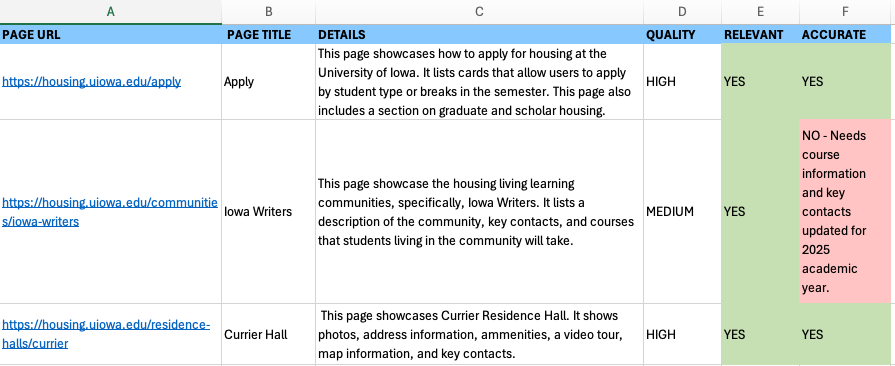Whether you’re at the beginning of a website redesign, working with a newly launched site, or managing an established one, one thing is certain: all websites require updates at some point. From content and images to pages and files, regular maintenance and content governance is essential to keep a website fresh and relevant. One of the ways to ensure your University of Iowa website stays up-to-date is through a powerful often overlooked technique by many: a content audit. In this article, we’ll dive into what a content audit is, why it’s important, how and when to conduct one, and how it differs from a content inventory.
What is a content audit?
A content audit is an essential process that ensures your website’s content remains fresh, relevant, and aligned with your audience’s needs. Whether your site is brand new or has been around for a while, regular content audits help improve existing content and identify gaps or areas of improvement. University websites, in particular, need regular updates to maintain accuracy and keep audiences engaged.
Without regular content audits, websites can quickly become cluttered with outdated or irrelevant information. That is where a content audit comes in. Put simply, NNGroup defines a content audit as one that examines, assesses, and evaluates the quality of the content listed in the inventory. Audits uncover content that needs updating, where gaps exist that new content could fill, and if certain pieces of content are ready for removal. This helps ensure your website continues to serve its purpose and speak to your audience effectively.
Should I conduct a content audit, and why does it matter?
You might not realize it, but many website managers neglect content audits, even when a site is newly launched. After a new website goes live, it’s tempting to think everything is complete, but without ongoing updates and content governance, your site can quickly become irrelevant or less helpful to your audience. A content audit helps you spot gaps, find outdated information, and ensure the overall quality of your content remains high. By conducting audits regularly, you can address potential issues before they become significant problems. Just as you don’t wait for a major health issue to see a doctor, don’t wait for your website to suffer—keep it maintained and relevant. Schedule time for a content audit in your web content management process, whether your Iowa website is well-established or newly redesigned.
How to conduct a content audit
There are several approaches to conducting a content audit. Below are a couple different ways you could do this:
One approach could be to create a spreadsheet where you can catalog your content and assess its quality and relevance. You could set up spreadsheet columns with titles such as: page URL, page details, content quality, accuracy, and relevance. Below is an example of how a content audit could be conducted with a spreadsheet.

An example of a content audit on housing.uiowa.edu. This example assess content for quality, relevancy, and accuracy. - Alternatively, you could gather your content editors for regular meetings to review specific pages of your site, discussing what needs updating and ensuring the content is still accurate and aligned with your site’s goals. When discussing content with editors, you could start by considering a few key questions: When was this content last updated? Is it still relevant to our website? And is it still accurate? You don’t need to try to fix everything at once—focus on the key pieces of content that will have the biggest impact. Start with high-traffic pages, like the homepage and contact page, and then work your way down to the less-visited pages. This way, you’re making sure the most important content gets attention first. The key is to establish a process that works for your team and ensures your content remains fresh and relevant.
Is there a difference between a content audit and a content inventory?
The short answer is yes, they are different. A content audit looks at the quality, accuracy, and relevance of your content, whereas a content inventory is a list of every piece of digital content you currently have, captured at either the page or asset level. It includes specific characteristics about each piece. A content inventory includes detailed characteristics of each piece, whereas an audit takes a closer look at how effective and up-to-date that content is.
Should you do both? Absolutely. It's essential to track all your content while also assessing its quality. You can use a similar approach for both tasks. We've included two templates here for you to use for a content audit and content inventory.
Regular content audits are an excellent way to ensure your website stays relevant and of high quality. However, it's important to remember that no website is ever really "finished." Maintaining accuracy, relevance, and overall health requires ongoing effort. We recommend making content audits and inventories a regular part of your content management and governance routine, ensuring that your University of Iowa website stays up-to-date, relevant, and fully aligned with your audience’s needs. By building this into your workflow, you can keep your website performing at its best and continue to tell the Iowa story in a powerful way.